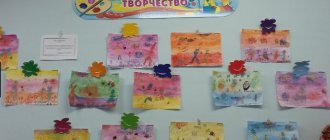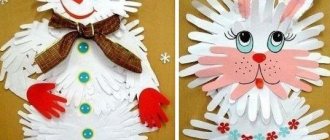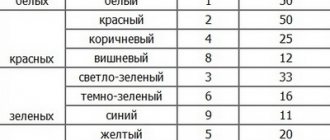Summary of a lesson on life safety for the preparatory group
Lesson for the preparatory group
Topic: “Dangerous situations: contacts with strangers on the street” Integration of educational areas: “Cognitive development” (introduction to sociocultural values: expanding the horizons of children) “Social-communicative” (formation of the foundations of safety); “Speech development” (coherent speech; introduction to fiction, “Physical development” (formation of initial ideas about a healthy lifestyle; physical education: formation of the idea that physical education movements help restore strength and relax the child’s body). Types of children’s activities: cognitive, communicative, playful, motor, perception of fiction. Goal: to form in children the desire to preserve life and their health through typical dangerous situations with possible contacts with strangers on the street. Objectives: • educational: to continue to form children’s understanding of how to properly behave in dangerous situations on a visual and verbal basis; explain to children that the pleasant appearance of a stranger does not always mean his good intentions and, conversely, an unpleasant or ugly appearance does not always mean bad intentions; teach children to observe some safety measures, developing Algorithm of behavior in an unexpected dangerous situation; • developing: develop logical thinking, ability to compare; develop interest and curiosity in children; develop coherent speech (reasoning) and the ability to briefly and accurately answer the teacher’s questions and coherently express one’s thoughts; activate children's vocabulary through words and expressions: pleasant and unpleasant appearance; stranger; danger • educational: to instill in children a positive attitude towards the rules, even if they contain a prohibitive element, since the health and safety of the children themselves will depend on this. Material: clothes for playing out dangerous situations “A stranger offers candy to a girl”, “Stranger woman” pintograms for the Didactic game “Good and Evil”; presentation “Safety rules at home and on the street.” The progress of organizing direct educational activities for children Conversation “A person’s appearance can be deceiving.” Educator: - Children, who can be dangerous to humans? Children: (Animals. Other people.) Educator: - Can people be dangerous? Children : (They can.) Educator: - Which people can be dangerous? Why? Children: (People with an unpleasant appearance. Unpleasantly dressed.) Educator: - Who is more dangerous: men or women? Children: (Men are more dangerous than women. Both women and men are dangerous.) Educator: - A stranger, be it a woman or a man, a boy or a girl, so cheerful and cheerful, can also be evil and dangerous for a child. You can meet people with bad intentions among beautiful and neat people, and vice versa, you can meet people with good intentions among ugly, unpleasant-looking people. Educator: - So, what rule do you need to know? (You shouldn’t trust a stranger on the street, even if he is outwardly attractive.) Now let’s play with you and remember the fairy-tale characters, and the game is called “Good and Evil.” Didactic game “Good and Evil” The teacher explains the rules of the game: - There are 2 hoops on the floor, in one of them there is a pictogram of an evil person, in the other there is a pictogram of a good person. On the table are images of fairy-tale characters: Baba Yaga, Koschey, Barmaley, the snake Gorynych, the Snow Queen, Wolf, Fox, Thumbelina, Cinderella, Crocodile Gena, Aibolit. Educator: - Which of these heroes can be called evil and which ones good? Children's answers: ……. Educator: - Which of them do you think can be placed at the intersection of the circles? Why? Are the fox and the wolf evil in all fairy tales? In fairy tales: “Teremok” the fox is not evil or harmful, but the wolf in the fairy tale “Sister Fox and the Gray Wolf” is kind. This means that they can be placed at the intersection of circles and we have three groups: evil, good, good-evil. What fairy-tale character do these faces resemble in shape? (pictograms). Educator: Well done, you completed the task. – Which people are close to you? Children: (Dad, mother, grandmother, grandfather, brother or sister.) Educator: - Who is your acquaintance? Children: (Apartment neighbors. Group teachers. Friends.) Educator: - Who do you consider strangers, outsiders and strangers? Children: (All those people we don’t know.) Physical education lesson The teacher plays out the situation, puts on various costumes. 1. Situation “A stranger offers candy to a girl” Teacher: – Who did I play now? Children: (A stranger tries to treat a girl with candy) Teacher: - Yes. An adult treats the child with candy, or maybe treats him to ice cream, chewing gum and other sweets. What should you do? Children: (I will refuse the treat. I will say that you cannot take sweets from strangers. I will run away from the stranger.) Educator: - Will you warn your friends about this? How? Children: (We will warn you not to take anything from a stranger.) Educator: Be careful, Dear guys: Don’t trust strangers! If they invite you to visit, Or they give you some delicious candy, It’s better to run away from them quickly And warn all your friends... 2. Situation “Stranger” The teacher dresses up as an unfamiliar woman, approaches one of the children and asks the child “where do you live?, are your parents at home, who does he live with,” etc. Educator: Whom have I portrayed now? Children: An unfamiliar woman Educator: What will you do in this situation? Children: (I’ll say that I don’t have time to talk to you. I won’t tell you this, you’re strangers to me. I’ll shout loudly: “Someone else’s aunt is pestering me!”) Educator: Well done, you coped with the task. Lesson summary Educator: In fairy tales, miracles help fight the machinations of evil heroes. In life, rules for safe communication with unfamiliar adults help you avoid troubles associated with dangerous people. Now guys, I propose to consolidate these rules “Safety rules at home and on the street.” These rules must always be followed, even if you meet a person with a pleasant appearance!
We recommend watching:
Notes on drawing for the preparatory group of a kindergarten Conversation in the preparatory group on fire safety with a presentation Conversations on life safety in the senior preparatory group of the preschool educational institution. Card index. Quiz on life safety in the preparatory group
Similar articles:
KVN on fire safety in the preparatory group
Summary of the fire safety lesson “New Year’s tree.” Preparatory group
Life safety lesson “Rules of safe behavior on water.” Preparatory group
Life safety tasks for children 5-7 years old
Summary of a lesson on life safety in the preparatory group. Safety for children
Summary of a lesson on life safety in the preparatory school group "Children's Safety"
Program content: - consolidate children's ideas about the rules of safe behavior in various situations about dangerous objects; continue to teach how to prevent a dangerous situation using personal safety knowledge; consolidate the knowledge children have acquired about road signs; promote the development of cognitive interest, develop observation and attention; cultivate friendly relationships between children and responsiveness. Material: cards with letters, with road signs, ball. Preliminary work: working with visual materials.
with traffic signs, reading fiction, looking at illustrations. Progress of the lesson:
- Guys, look out the window - today the weather is beautiful outside, the sun is shining brightly and I hope that you are all in a great mood.
Our lesson today will take place in an unusual form, we will play with a ball, play educational games, answer many questions, solve riddles and solve a crossword puzzle in which the keyword is encrypted. And it also begins in an unusual way, the one who answers my question will be able to go to the chair (the chairs are in a semicircle). Are you ready? Then let's begin! 1. In which fairy tale did the hero go for a walk alone without adults? (bun) 2. What do games with matches lead to? 3. What is the name of the part of the road where people walk? 4. Why do you need to know your home address? 5. In which fairy tale did the sister leave her brother unattended? 6. Who helps put out the fire? 7. Where do passengers wait for the bus? 8. Where is it allowed to cross the roadway? 9. Is it possible to turn on the iron or gas independently, without adults? 10. In what fairy tale were they eaten because they opened the door? 11. Is it possible to play on the road? 12. What can happen if you eat unwashed fruit? - Well done, everyone completed the task. Today in the mailbox of our kindergarten there was a letter for the children of our group, let's read it? " Hello guys! Kindergarten students from the village of Chudakovo are writing to you. We really need your help! In our village we decided to build a new microdistrict, with large houses, we really want you to remind us of the rules of conduct in various situations. Thank you in advance." -Well, are you ready to help the guys? Then let's begin! At the beginning of each task, I will ask you a riddle, we will enter the answer into the crossword puzzle, and at the end of the lesson we will have a keyword. Task 1: Riddle: Steering wheel, wheels and pedals, Did they whisk me away on a long journey? (bicycle), (the word fits into the third row of the crossword puzzle, the letter “l”) -Now we will play the game “can-not”: in it we will determine the place to ride a bicycle. If possible, you clap your hands, if not, clench your fists. - You can ride at a bus stop - (not allowed) - In the yard, at the stadium, on the roadway, in a kindergarten, in a clearing, on the lawn, on the stairs, on the sidewalk? - Well done, we completed the first task. Task 2: Riddle: This multi-storey house is clean, bright, very important. You will meet different doctors here. They treat adults and children. You will lie in bed if you are seriously ill. We don't want to end up here! Where, tell me? In... (hospital) (sixth line of the crossword puzzle, word hospital, letter “c”). — Guys, can you remember a time in your life when you got very sick? What to do if your mother cannot cope with your illness? (call an ambulance). Now I will name a situation in which people may find themselves, offer two answer options, and you need to choose the correct one: The person has a fever. what to do: 1. Play outside? 2. Go to bed and call a doctor. Mom hides delicious candies high in the cabinet: 1. These are not candies, but medicine. 2. You can take it and eat it. The wind outside breaks the branches, the sky has darkened. 1. It’s better to go home. 2. You can continue to play outside. Mom has dishwashing detergents: 1. Take it yourself. 2. Wash dishes with adults. Mom was ironing her clothes and the phone rang: 1. Iron it yourself. 2. Turn off the iron. How to play computer games interestingly: 1. Play little by little 2. Play all day. Now we will play again, but first a riddle: Who will tell the pedestrians and he is standing by the road, In red he shouts “Stop”, In yellow he says “wait”, And the green one lights up, this means everyone “go” (traffic light) 3rd task: Didactic game "Traffic Light" (children are given cards with letters: C, B, E - on a red background, T, O - on yellow, F, O, R - on green. At the beginning of the game, the letters on the cards are pronounced, then while the music plays, the children move around the group, as soon as the music ends, you need to line up so that you get the word “Traffic light”) (The word “traffic light” also fits into the crossword puzzle on the fourth line, the letter “o”) Task 4
: a question for you, what question children most often ask .
to find out something (why?) and the next game called “Why?” (fits into the crossword on the first line, letter “m”) - In this game I will ask questions, and you will explain to me) - Why you can’t play with sharp objects (scissors, a needle...) - Why you can’t take washing powders, detergents without adult supervision? -Why can’t you light the gas stove yourself? -Why can’t you eat medicine? -Why can’t you eat a lot of ice cream and sweets? -Why shouldn’t children use electrical appliances? -Why can’t you call an ambulance or the police unless necessary? “What a great fellow you all are, you gave correct explanations to all the questions.” Task 5. Riddle: If something suddenly happens in the house - Smoke billows from the windows, And fire, and heat blazes - This means there... (fire), (second line of the crossword puzzle, letter “o”). Game with the ball “if there is a fire” - Now we all stand in a circle, I will say a poem, at the end of the verse the one to whom I throw the ball must finish the last word): - One, two, three, four - who has a fire in .... (apartment) - Smoke suddenly rose in a column, who didn’t turn off... (iron) - A red glow ran, who with matches... (played) - The table and the closet burned down at once, who dried clothes over... (gas) - Remember every citizen, this number...(01) - I saw smoke, don’t yawn and firefighters... (call) - It should be clear to everyone that messing with fire... (dangerous) 6th task: riddle: They stand on the roadsides, Silently speaking to us. Everyone is ready to help. The main thing is to understand them. (Road signs) (fifth line of the crossword puzzle, letter “d”) - We all know that while driving around the city we must pay attention to road signs. Our next game is "Road Signs". Each of you will take a card with a sign, name this sign and tell what it means. - Well done, so you and I helped the guys from the village of Chudakovo, reminded them how to behave safely in various situations on the road. and I really hope that you and all the guys will always follow these rules.
Answering questions and solving riddles, we solved with you almost all the lines of our crossword puzzle, except for the last letter, and of course you guessed it. that this is the letter "s". What word did we get? "WELL DONE." Because you answered everything correctly today, because you were smart and kind to each other, I would like to give you friend emblems. Thanks for your help and see you again!
We recommend watching:
Quiz “Experts of fire safety rules” for the preparatory group of kindergarten
Similar articles:
Lesson in the preparatory group “Fire – friend or foe?”
Fire safety lesson in the preparatory group. Caution - electrical appliances!
Life safety classes in the preparatory group. Card file with goals according to the Federal State Educational Standard
Summary of a lesson on life safety in the preparatory group. Emergencies
Lesson notes for the preparatory group. Dangers are all around us
Comprehensive life safety lesson
(senior group)
Goal: consolidation of fire safety knowledge.
Tasks:
— To consolidate children’s knowledge about dangerous situations, causes of fire and rules of conduct in case of fire;
- learn to navigate problem situations;
- introduce fire and its properties;
— consolidate children’s knowledge about the profession of firefighter;
— expand children’s vocabulary on the topic of fire safety;
- instill in children the need to take care of their safety;
— continue to introduce non-traditional techniques in art activities.
Equipment: firefighter uniform (helmets, mask, carabiner, boots...), photographs depicting fire equipment, firefighter uniforms before and now; pictures with illustrations of fire safety rules; video "firefighters in training." Materials for experiments with fire: metal tray, candles, containers with water, sand, earth, glass flask. Materials for art activities: sheets of white paper, watercolors, brushes, jars of water, transparent film the size of a sheet of paper, silhouettes of a fire truck, houses, a fireman made of dark paper, glue.
Progress of the lesson:
Educator: Guys, today we are going on an exciting and useful journey through the country of security. I invite you to
get on the bus (children sit on chairs simulating a bus). While we are driving, I will tell you a story.
“In one small town there lived a match. She was a cheerful, playful girl. She really loved to dance, and she danced so much that she forgot about everything in the world. It ignited and immediately caught fire. While dancing, she touched curtains, objects in the house, going out into the street - behind trees, houses, bushes, grass and everything that came in her way. It all burned down. People began to fear her. She didn't like it terribly, because only people could give her life. After all, they were the ones who did it. And then one day she came to the master who made matches and asked for help. After all, she wanted to benefit people, but only brought harm. The master thought well and decided to help the match. I came up with a house for her where she can hide and relax - it’s a matchbox. He put her not alone, but with her sisters. Since then, the naughty match has lived in a matchbox.”
Did you like the fairy tale? I suggest you play the game “The Benefits and Harms of Fire.”
Educator: We light a fire with a match. And what benefits does fire bring?
Children: With the help of fire we cook food, heat our homes, and light our houses.
Educator: What harm does fire cause? What can happen from careless handling of fire?
Children: Things can burn, an apartment, a house, a forest.
Educator: What causes fires?
Children: Fires happen from playing with matches, lighters, from leaving electrical appliances on, or from gas stoves.
Educator: Well done, guys. Here we are. First stop.
Fire Safety Museum.
Come into the first hall of our museum. There is an “art gallery” here. She's unusual, can you guess why? (each picture shows rules for safe behavior with fire.
Children look at each picture, explain why a dangerous fire situation arose and how to act in this case. After each child’s explanation, the teacher draws a conclusion using poetic form.
— Rule one applies to everyone, rule one is the most important! On the street and in the room, guys remember him. Don't touch the matches, there's fire in the matches!
— Rule two is easy to remember: be careful with electrical appliances, with an iron and a kettle, with a stove and a soldering iron!
— Rule three: Don’t leave burning gas, you need to keep an eye on the gas
— Rule four: we want to warn you, do not light the stove without an adult
— Rule five: It’s nice to sit by the fire in the forest, but when it’s time to return home, before leaving, don’t spare the fire, cover it with earth and fill it with water
Guys, if you and I follow these rules, trouble will never happen to us.
Who helps people cope with the fire? (firefighters). You and I will learn about the profession of a firefighter if we go to the next hall of our museum. Come on in.
What do you know about the fireman's uniform? Look at the uniform a firefighter used to have (pay attention to photographs of past firefighters
years). Now look (I pay attention to the modern uniform): the fireman is dressed in a special suit that does not get wet and does not burn in a fire. Tell me, why does a firefighter need a helmet? (It protects the head from blows if something falls on the firefighter). I suggest trying on a helmet (old and new). Children share their impressions. When a fire occurs, it is very dangerous, and putting out a fire is not easy. What do you think a firefighter should be like? (brave, courageous, strong, courageous, kind). What kind of people won't be hired as firefighters? What does it take to become a firefighter? (play sports, be able to listen, know a lot of rules for saving people).
Let's go to the cinema hall of our museum and see how firefighters train (watch the video “firemen in training”).
Our journey continues. We take our places. The teacher asks the children questions: What equipment helps firefighters, why is the fire truck red, what number should be dialed to call the firefighters, what should you say?
Next stop
“Experimental Laboratory”
Here we will conduct experiments with fire. Let's get acquainted with fire and its properties. To get into the laboratory, you need to go through a tunnel (they crawl under an arc). A million years ago, people learned to make fire. In human hands it gave light and warmth. People cooked their food on fire and protected themselves from wild animals that could attack a person. But as soon as the fire was given free rein, left unattended, good actions turned into evil. Fires still occur to this day. And very often where people handle fire carelessly. People get burns and poisoning. Now we will conduct experiments with fire. And we will be very careful.
The teacher lights the candles. Children, what did you see? (light). It is bright, beautiful, and attracts attention. Can I touch it? Explain why? (children's answers)
Experience 1. If a fire becomes dangerous, how can a person cope with it? (put it out). What is fire afraid of? (water, snow, sand, earth).
Let's check your statements. Let's conduct an experiment: pour a little water on a burning candle (the child follows the teacher's instructions). What's happening and why? (the fire has gone out, he is afraid of water).
Experiments 2, 3. They are carried out similarly with other materials: sand, earth (if the lesson takes place in winter - snow).
Experiment 4. Now let’s carry out the last experiment and draw the appropriate conclusions. Cover the burning candle with a glass flask. What happens to the fire (it goes out). Why did the fire go out? Fire cannot exist without air. Therefore, when the air supply stopped, it went out.
This concludes our work in the laboratory, let's continue on our way. On the bus he asks questions: Can children use matches, can they turn on electrical appliances themselves, how can they put out a fire, what should be done if a fire does happen?
I want to give you one piece of advice:
Who is careless with fire?
There's a risk of fire
Guys, remember that
That you can't play with fire.
This is where our journey ended, we returned to kindergarten. Did you like our trip? Let's play (the outdoor game “Fire” is being held / Lifestyle life for preschool children / Detstvo-press, 2010, p. 160)
Today we learned a lot, and now I invite you to depict in your drawings how the fire started and how firefighters deal with it (drawing is done in an unconventional technique with elements of the applique “Brave Firemen” / collection “Merry Christmas “ROSMAN”, 1996 , p.8).






